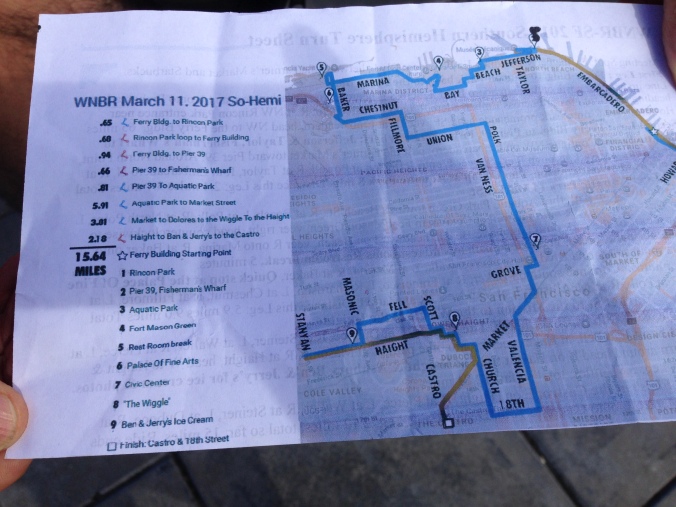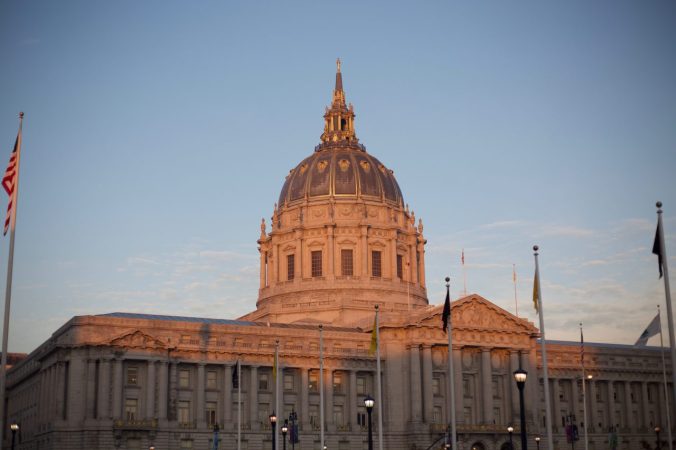Tony Whitaker spends his days sifting through the grass at the Civic Center Plaza with a pair of trash tongs, blue latex gloves, a trashcan and a red biohazard disposal box in search of discarded hypodermic needles. The full-time Department of Recreation and Parks employee spends five days a week picking up trash and other hazardous materials from various parks throughout the city but finds more needles in the Civic Center then anywhere else.
“There are several parks I take care of, but I find significantly more needles at the Civic Center than the other parks I tend to,” Whitaker said as he sifted through the grass with his trash tongs outside the new Helen Diller Park at the Civic Center Plaza. “I have to rake the grass because children play out here and it’s where I find most of the needles, about 30 a day.”
The city has taken many approaches to combat the issue of discarded hypodermic needles in public areas but has yet to find a tangible solution that works. Needle disposal drop boxes are located throughout the neighborhood as well as at the Bart station entrance, but Whitaker says these attempts do little to keep the streets clean.
“I personally go out of my way and leave two or three red biohazard boxes out, and when I come back to collect them I find the syringes scattered all over the ground,” he said.
While violent crime statistics are reported to be lower in the Civic Center this year, according to the SF Controller’s 2016 Street and Sidewalk Maintenance Standards report, San Francisco has experienced a 41 percent increase in hypodermic needles on the city’s sidewalks and streets.
The study found 3,551 needles citywide during the 2016 fiscal year, an increase of 1,024 needles from 2015. Despite the city’s attempts to curb this problem, the issue continues to persist especially in the Civic Center which is characterized as a “needle hotspot.”
Local law enforcement agencies and non-profits alike have tried to tackle this challenge albeit with different approaches. The neighborhood community benefit district has been working to combat this issue since its inception in 2012. The Civic Center Community Benefit District has a dispatch hotline which is open to call seven days a week and a response team consisting of neighborhood ambassadors who clean and discard any hazardous items.
“Needles have been an issue for a long time and we’ve been dealing with discarded syringes since we began operations in 2012,” said Executive Director Donald Savoie of the Civic Center Community Benefit District. “Our ambassadors are trained in everything from police codes to public health related matters, and they always carry the necessary materials to safely discard needles and other hazardous materials within the Civic Center neighborhood.”
Savoie also explained some changes the city has made to control the needle issue with respects to the enclosed public bathroom units located on Hyde and Grove as well as in front of the Bill Graham Civic Auditorium.
“The enclosed bathroom units were once used for anything from sex to drug use and were really trashed and disgusting,” he said. “They’re now staffed full-time to ensure they are used only to go to the restroom, and they also have a needle disposal drop box located outside the bathrooms for those who want to discard used syringes.”
The full-time workers who monitor the enclosed bathroom units are Department of Public Health employees and supervise the bathrooms seven days a week from 8 a.m. to 9 p.m. They are trained to safely discard used syringes and have on hand all the required items to do so.
The San Francisco Public Library has worked on this issue as well and has collaborated with the Department of Public Health in many ways to decrease the amount of discarded needles in the area and around the premises of the main library which is located on Larkin Street right at the edge of the Civic Center Plaza.
The library currently has on staff DPH workers who patrol the perimeter of the library for discarded needles as well as a full-time social worker, a social safety aide and a police officer who leads their security unit.
“We have a team of individuals comprised of DPH workers, social workers and a social safety aide many who are trained to administer life-saving medicines to those who are experiencing drug overdoses,” said Katherine Jardine, the public relations officer for the San Francisco Public Library. “Our DPH workers are affiliated with the drug overdose prevention and education project (DOPE) and understand how to properly use Naloxone on anyone experiencing a heroin or opioid overdose.”
The library is considering the possibility of offering training to any library staff members who would want to volunteer and learn how to administer Naloxone to overdose victims, but the idea is still pending. Naloxone is a drug known to reverse the effects of heroin overdoses and is also commonly referred to by its brand name Narcan.
The Bart police have taken a different approach and are enforcing the law to stop drug behaviors on public grounds. They recently carried out a 3-day sting operation in an attempt to crack down on public drug use in the Civic Center Bart station. The operation included plainclothes police officers and BART’s Critical Assessment Protection team and resulted in 27 arrests for drug use in public.
“We want to send a clear message that drug use at our stations will not be tolerated,” acting Police Chief Jeff Jennings said in a press release. “This illegal activity impacts our riders and employees as the users leave behind hazardous items.”
The district attorney is said to be bringing strong charges against the individuals arrested in the 3-day sting, and a joint operation between BART police and the San Francisco Police Department are in the works.
Leane Debono, a homeless man who resides in the Civic Center, doesn’t feel as though these arrests will do much to prevent drug use in public places.
“People using in public has gotten a lot better in recent years, but arresting people and throwing them in jail isn’t going to stop it,” he said while waiting for the public library to open. “The police and everyone else around here don’t really care what goes on. They may have put drop boxes around, but there’s no real incentive to change the way it is down here. You can shoot up on any street corner around here and no-one does anything about it.”
While it may appear that no-one cares, the demographic of those living in this neighborhood is changing quickly, and the new residents may be the driving force for this attempt at change.
San Francisco’s Civic Center and Mid-Market neighborhoods are transitioning areas within the city. These once well-known crime-ridden areas now house luxury apartments and sprawling food courts that cater to the city’s top earners.
New restaurants and gastropubs now line Market Street and construction sites can be seen on nearly every street corner. A new $10 million park is currently being assembled in the Civic Center Plaza, and a handful of high rise apartment complexes are currently being built on Market.
Even with all this transformation the one thing that hasn’t changed is the open display of drug use on the neighborhood streets and plazas. It may not be a new reality, but discarded needles and drug use in public are issues that are getting increased attention from city officials and the community alike. It will take time to see if these new approaches to combatting drug use in public will produce positive effects, but the city and other organizations don’t appear deterred from trying everything they can to clean up the streets in the Civic Center.

 The center of San Francisco’s downtown area rests at the heart of the Civic Center. San Francisco’s Civic Center and mid-Market neighborhood consist of various state and federal government buildings, museums, theaters and many new development projects. It is also a designated national historic landmark.
The center of San Francisco’s downtown area rests at the heart of the Civic Center. San Francisco’s Civic Center and mid-Market neighborhood consist of various state and federal government buildings, museums, theaters and many new development projects. It is also a designated national historic landmark.